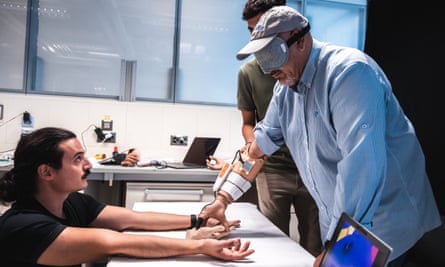Whether it is a simple handshake or a full-body hug, the warmth of another person adds a human touch to social interactions. Now researchers have created a device that allows people with amputations to experience such natural temperature sensations using their prostheses.
The team say the innovation is a first and paves the way for integrating a host of sensations into artificial limbs.
Prof Solaiman Shokur, a senior author of the research at the Swiss Federal Institute of Technology Lausanne, said it was known that boosting sensory feedback from a prosthesis could help people feel an artificial limb was part of their body.
“To give a natural sensation, you cannot do it without temperature,” he said.
Shokur added that the approach could also enable people with artificial limbs to perceive whether an object was dangerously hot and help them distinguish between different materials.
“Beyond that it opens a window to the more social aspect of touch,” he said.
Writing in the journal Med, Shokur and colleagues report how they previously showed it was possible to create a person’s perception of warmth or coolness in an amputated hand by heating or cooling specific points on the remaining part of their arm.
Building on this phenomenon, the team created the MiniTouch in which a temperature sensor was placed on someone’s prosthetic hand at the location the phantom thermal sensations seemed to arise from.
When the sensor detected a change in temperature away from a baseline of 32C, it sent a signal to a temperature controller. This relayed the information to another component that was mounted on the upper part of the prosthesis and touched the skin of the arm.
The temperature that had been detected by the sensor was then reproduced on the arm at the trigger location for the phantom sensations. In the current study, the device reproduced temperatures from 20C to 40C.
The upshot is that the person perceived a thermal sensation in their missing hand, at the location of the temperature sensor.
To test the MiniTouch, the researchers fitted it to the prosthesis of Fabrizio, a 57-year-old whose right arm was amputated below the elbow.
The team found when using the device Fabrizio could discriminate between identical-looking bottles containing cold, hot, or room-temperature water, with 100% accuracy. When the device was switched off, his accuracy was 33%.
Fabrizio was also able to distinguish between slabs of copper, glass, and plastic using the MiniTouch when blindfolded, with an accuracy equal to when using his other, intact hand. When the device was switched off, however, his choices came down to chance.
In addition, the MiniTouch increased Fabrizio’s ability to distinguish between real and prosthetic arms when blindfolded – although his accuracy was higher with his intact hand, said Shokur, possibly because it also sensed information such as texture.
The device also improved Fabrizio’s accuracy, although not speed, when sorting a box of hot and cold steel cubes in the space of one minute.
Fabrizio said the phantom sensation in his missing hand was more intense than in his intact hand when perceiving hot or cold cubes.
“When I had my accident when I was 20 years old, I tried a prosthetic hand that gave me a simple movement; instead, with these new technologies, I can understand better what I am touching,” he said.
While the authors say the device should be tested in a larger group of patients, they note the MiniTouch does not require surgery and is based on readily available electronics – meaning it can be bolted on to existing prosthetics, can easily be personalised, and is relatively inexpensive.

Prof Silvestro Micera, another senior author of the paper from the Swiss Federal Institute of Technology Lausanne and the Sant’Anna School of Advanced Studies in Italy, said the team was now planning to create a single wearable system that would give people with amputations the ability to experience many different sensations using their prostheses – including pressure, texture, position, temperature and wetness.
“This would be for us the [really] big next step,” Micera said.
Dr Sigrid Dupan, an expert in sensory feedback for prostheses at University College Dublin, who was not involved in the study, said the fully integrated system was a big step forward in the research of thermal feedback for artificial limbs, and could help people feel their prostheses were part of their bodies.
But she cautioned that the team previously showed it was not possible to trigger phantom thermal sensations in all people with amputations, while they were not consistent in some.
“I’m excited about the research and it shows promising developments, but … people can’t expect the implementation of these new devices into our healthcare system in a short timeframe,” she said.